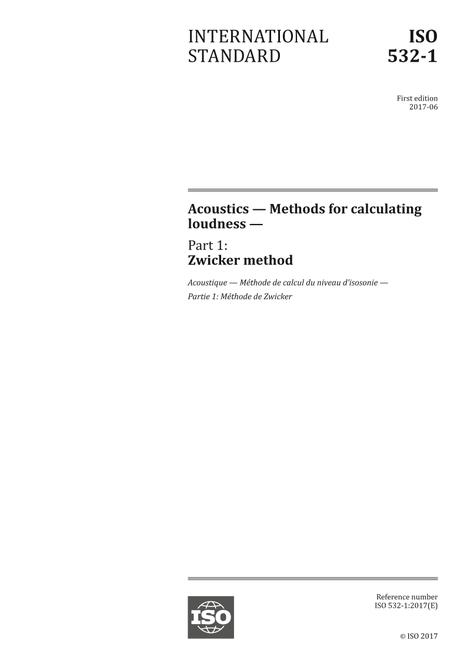-
-
Available Formats
- Options
- Availability
- Priced From ( in USD )
-
Available Formats
-
- Secure PDF 🔒
- Immediate download
- $368.30
- Add to Cart
-
- Printed Edition
- Ships in 1-2 business days
- $368.30
- Add to Cart
-
- Printed Edition + PDF
- Immediate download
- $497.84
- Add to Cart
Customers Who Bought This Also Bought
-

ISO 532-1:2017
Priced From $250.00 -

ISO 3740:2019
Priced From $194.00 -

ISO/IEC Guide 23:1982
Priced From $48.00 -

ISO 226:2023
Priced From $166.00
About This Item
Full Description
The methods can be applied to any sound recorded as single-channel measurements using a microphone, or as multi-channel measurements, for example by means of a head and torso simulator (see Annex D). Since most important technical sounds are time-varying, a model of time-varying loudness is preferable.
The methods are based on the Zwicker algorithm.[14] The method for stationary sounds is provided for reasons of continuity and also offers the use of measured one-third-octave-band levels as input. The more general method for arbitrary sounds calculates the specific loudness pattern based on measured time signals by applying a signal processing model that is directly related to physiological and psychological characteristics of the human hearing system. Loudness is calculated from the specific loudness pattern. It has been shown that this method provides a good match to the results of many loudness experiments using synthetic and technical sounds.
No prior knowledge about the properties of the sound (e.g. broadband or narrowband noise, tonal content) and no user interactions are required for the fully automated application of the method.
The evaluation of the harmful effect of sound events is outside the scope of this document.
Cross References:
IEC 61260-1:2014
IEC 61672-1:2013 DIN 45631:1991
IEC 60050-702:1992/AMD2:2016
ISO 80000-8:2007 Ed 1
ISO 226:2003 Ed 2
ISO 532:1975
ISO 9612:2009 Ed 2
DD IEC/TS 60318-7:2011
ISO 3740:2000 Ed 2
ISO 11200:2014 ED2
ISO 226:1987
ISO/IEC GUIDE 98-3:2008 Ed 1
ISO 1996-1:2016
All current amendments available at time of purchase are included with the purchase of this document.





